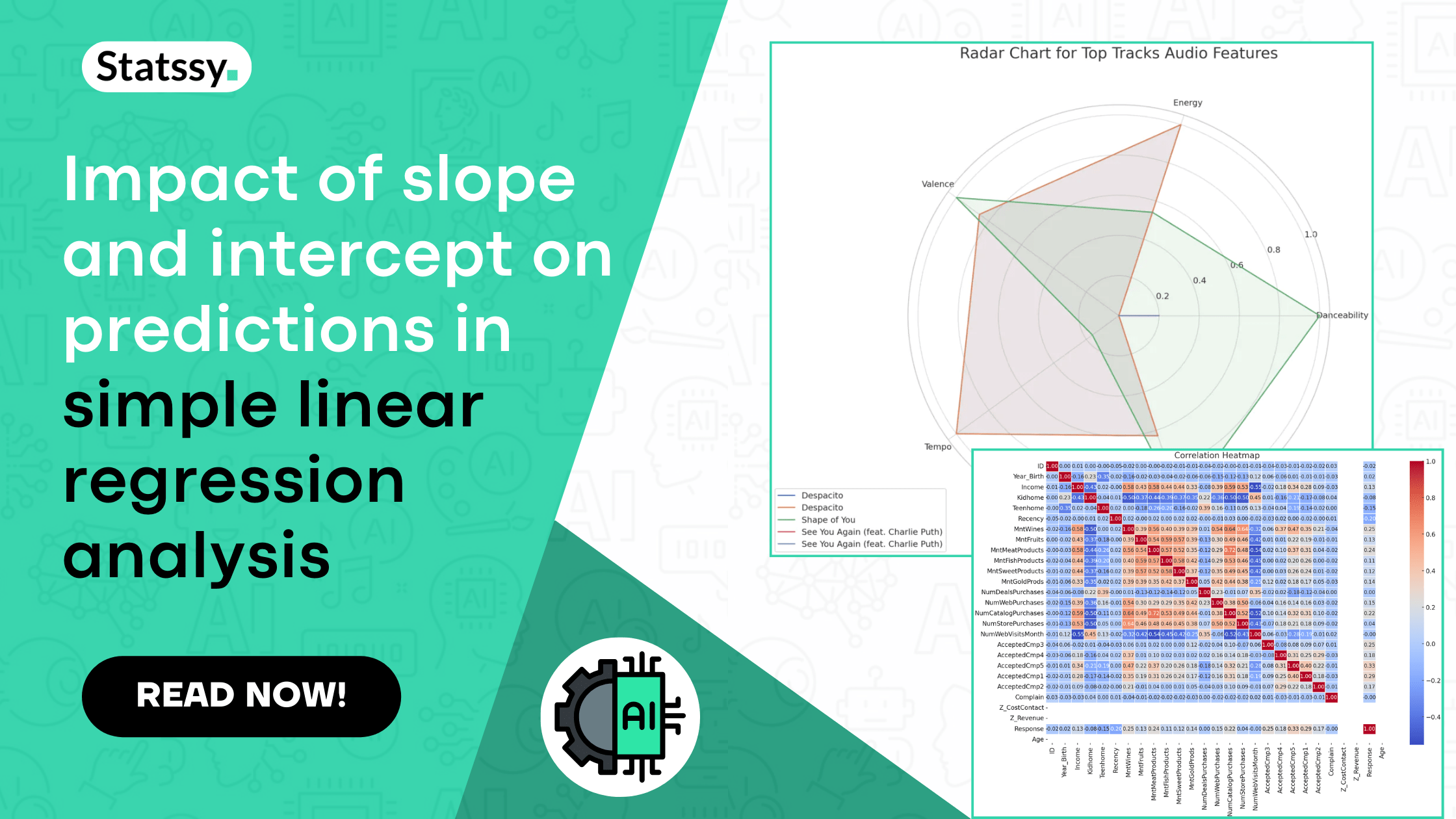Table of Contents
Introduction: Impact of slope and intercept
Hey dear reader. Welcome to Statssy!
Ever wondered if you could predict the future? Well, in a way, you can with Simple Linear Regression! This might sound like some high-brow statistical term, but it’s actually super relatable. Think about it – we’re always trying to guess what’s going to happen next, right?
Whether it’s your next TikTok going viral or how many likes you’ll get on your new Insta post, we’re constantly making predictions.
Now, let’s take this a step further. Imagine being able to use some simple math to actually make these predictions more accurate. That’s where Simple Linear Regression comes in. It’s like a crystal ball for your data. And no, you don’t need to be a math whiz to get this – it’s surprisingly straightforward.
Here are 10 everyday examples where you’re already using the concepts of prediction, and how linear regression is just a formal way of doing what you intuitively do:
- Social Media Growth: Predicting how many new followers you’ll gain based on your posting frequency.
- Fitness Goals: Estimating how much your run time will improve if you train consistently every week.
- Budgeting for Shopping: Guessing how much you’ll spend on online shopping based on past spending habits.
- Streaming Series: Calculating how long it will take to finish a Netflix series based on your current binge-watching pace.
- Studying for Exams: Forecasting your exam scores based on the number of hours you study.
- Gaming Skills: Estimating how your gaming scores improve as you play more.
- Cooking: Predicting the time it takes to bake a perfect cake based on oven temperature.
- Travel Planning: Guessing how much a trip will cost based on the duration and destination.
- Music Playlist: Determining how many new songs you discover weekly based on time spent exploring music apps.
- YouTube Channel Growth: Anticipating the increase in subscribers with more frequent and engaging video uploads.
Each of these examples is a form of prediction based on patterns. Slope and Intercept In Simple Linear Regression, we use a bit of math to make these predictions more precise.
Instead of just guessing, we’ll be using data and a straightforward formula to see into the future of our interests. Think of it as leveling up your predictive powers!
So, buckle up! We’re about to embark on a journey that will not only make you awesome at predicting stuff but also super savvy with data. And the best part? You’ll see how math can be super cool and directly applicable to your everyday life. Let’s dive in!
What’s Simple Linear Regression Anyway?
Simple Talk: Forecasting Your World
Alright, let’s break down what simple linear regression really means in the simplest way possible. Imagine you’re trying to boost your followers on Instagram. You’ve noticed that the more you post, the more followers you seem to get. But how can you figure out exactly how many followers you’ll gain with each new post? This is where linear regression comes to the rescue!
In the world of linear regression, we’re basically playing detective with numbers. You take the data you have (like your posting frequency) and use it to make educated guesses (a.k.a predictions) about what you don’t know (like your future follower count). It’s like connecting the dots, but the dots are your past actions and future results.
Why It Matters: More Than Just Numbers
Now, you might be thinking, “Cool, but why should I care about this in real life?” Well, here’s the deal: understanding linear regression isn’t just about predicting social media stats. It’s a skill that applies to so many areas, especially in business analytics.
- Marketing Insights: Just like predicting followers, companies use linear regression to estimate the impact of their marketing campaigns on sales.
- Financial Planning: Ever wondered how banks decide who gets a loan and who doesn’t? Yep, they use similar techniques to predict financial risks.
- Sports Analytics: Coaches predict how changes in training affect an athlete’s performance to plan better strategies.
- Academic Success: Schools can predict student performance and provide the right support at the right time.
- Healthcare Trends: In healthcare, it helps in predicting patient outcomes based on treatment plans.
- Retail Stocking: Retail giants forecast sales to decide how much stock to keep for each product.
- Weather Forecasting: Meteorologists use similar concepts to predict weather patterns.
- Real Estate Pricing: Agents estimate house prices based on location, size, and other factors.
- Tech Innovations: Tech companies forecast user growth to plan their infrastructure and resources.
- Personal Finance: And yes, you can even use it to manage your personal budget and spending.
Each of these examples shows how linear regression is super relevant, not just in your personal life but in shaping the world around you. By mastering this skill, you’re not just learning to predict followers or grades; you’re unlocking a crucial tool that can influence major decisions in almost every field you can think of.
So, are you ready to see how linear regression works and how you can use it to your advantage? Let’s get started!
The Magic Formula: y = mx + b
Breaking It Down: Decoding the Formula
Time to introduce the star of the show: the linear regression formula, y = mx + b. This might look like a random mix of letters and symbols, but it’s actually a super simple yet powerful formula. Let’s decode it using our Instagram example:
- ‘y’ – Your Goal: Think of ‘y’ as your target, like the number of followers you’re aiming to reach. It’s what you want to predict or find out.
- ‘x’ – What You Know: This is the data you already have. In our Insta scenario, ‘x’ represents your weekly posts. It’s the factor you think is influencing your goal.
- ‘m’ – The Game-Changer, a.k.a. the Slope: Here’s where things get spicy! ‘m’ is the slope, and it tells you how much impact each of your actions (like a post) has on your goal (gaining followers). A higher slope means each post makes a bigger difference. A low slope? Not so much.
- ‘b’ – Your Starting Block: ‘b’ stands for the y-intercept. In simple terms, it’s where you begin before you even start your efforts. For your Instagram, it’s your initial follower count before you change your posting strategy.
Putting It Into Perspective
Let’s say you’ve got 500 followers now and you’re posting twice a week. You notice that every time you post, you gain around 10 new followers. So, in the formula:
- Your starting point (initial followers), ‘b’, is 500.
- Your weekly posts, ‘x’, is 2.
- The impact of each post (slope), ‘m’, seems to be around 10 followers per post.
Plugging these into the formula, it would look like y = 10x + 500. This means if you post twice a week (‘x’ = 2), your expected new follower count (‘y’) would be 10 * 2 + 500 = 520 followers.
Why This Is Super Cool
Understanding this formula is like having a secret weapon. It’s not just about predicting social media trends; it’s a fundamental concept in business analytics, economics, environmental science, healthcare, and more. Whether you’re looking to optimize a marketing strategy, forecast sales, or even analyze environmental data, this formula is your key to unlocking a world of predictions.
So, there you have it! The magic formula isn’t just a bunch of letters and numbers. It’s a roadmap to understanding how changes in what you control can impact your goals. And the best part? You can apply this to pretty much anything. Ready to see how? Let’s roll on to the next part!





